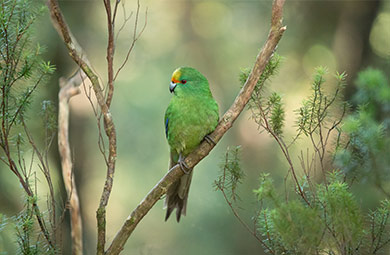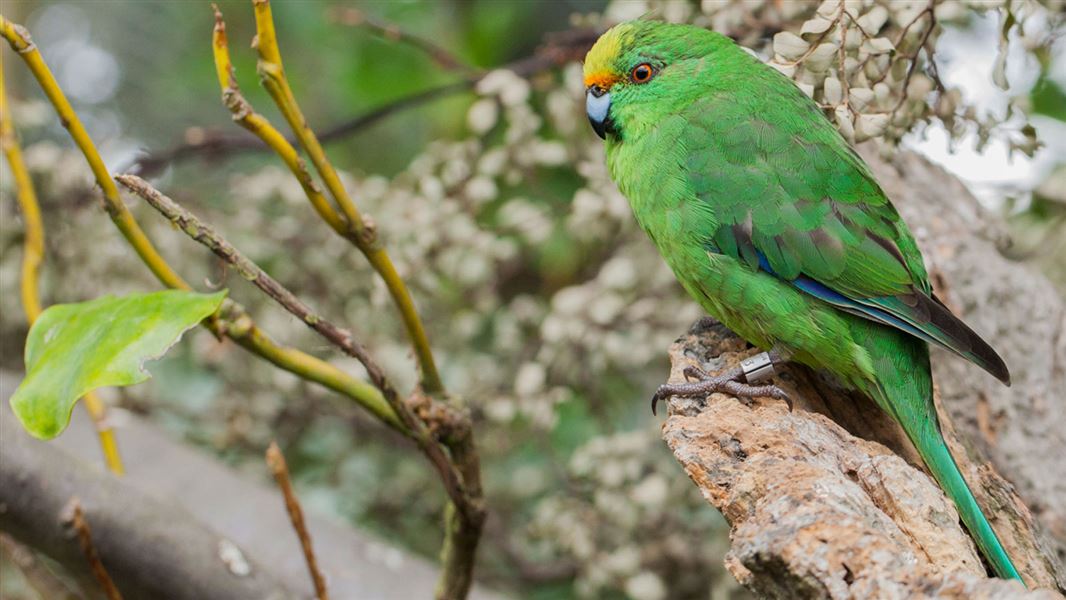Population: About 300-450 in the wild – the population fluctuates naturally
New Zealand status: Endemic
Conservation status: Threatened–Nationally Critical
Found in: Two alpine beech forest valleys in Canterbury (the Hawdon and Hurunui South Branch), Ōruawairua/Blumine Island in the Marlborough Sounds, the Brook Waimārama Sanctuary in Nelson and Pukenui/Anchor Island in Fiordland’s Tamatea/Dusky Sound
Threats: Predation, habitat loss
Species information: Orange-fronted parakeet on NZ Birds Online
Donate
Christchurch Helicopters has partnered with the NZ Nature Fund (NZNF) and DOC to help save orange-fronted parakeets. NZNF is a charitable trust that holds donated funds so donors have independent assurance they will be applied to DOC’s orange-fronted kakariki recovery programme.
Orange-fronted parakeet conservation
Overview
Kākāriki karaka were once found throughout Aotearoa but the impacts of predators and habitat loss has seen the population decline to several hundred birds at just a handful of sites. They have twice been declared extinct and then rediscovered in the past.
Recovery Programme
DOC and Te Rūnanga o Ngāi Tahu lead a recovery programme which is vital to the species’ survival. It’s focused on monitoring and protecting those sites where kākāriki karaka are found, breeding birds in captivity to release into the wild, research, and finding safe new sites where the species can be introduced.
We have worked closely with our Tiriti o Waitangi partner Te Rūnanga o Ngāi Tahu for decades to protect kākāriki karaka and bring this precious manu (bird) back from near extinction.
The passing of the Ngāi Tahu Claims Settlement Act 1998 enabled Te Rūnanga o Ngāi Tahu to appoint representatives to work alongside DOC kaimahi to protect their taonga. These taonga species experts are the voice of nearly 80,000 Ngāi Tahu whānau.
The Ngāi Tahu representatives bring centuries of mātauranga māori (knowledge), as well as their values of rangatiratanga, kaitiakitanga, and manaakitanga which are woven through their mahi and our joint decision making.
Current Te Rūnanga o Ngāi Tahu Kākāriki Karaka Representative Yvette Couch-Lewis (ONZM) has been representing her iwi and working with DOC for more than 20 years. Her mahi and expertise to protect kākāriki karaka was recognised in the 2021 Queens Birthday Honours when she received an Order of Merit for her services to conservation.
The programme works closely with captive breeding partners such as The Isaac Conservation and Wildlife Trust and Orana Wildlife Park. Canterbury University, MainPower, RealNZ, Christchurch Helicopters, NZ Nature Fund and Formthotics also support the work.
In 2021, the recovery programme was boosted by a four-year Jobs for Nature project focused on preventing the extinction of kākāriki karaka, leading to more research, predator control, and monitoring for the species, as well as translocations to establish new wild populations.
The recovery programme relies on captive breeding to support existing wild populations and establish new populations in safe sites. Captive breeding started in 2003, when eggs were taken from the wild and foster manu successfully raised the offspring.
Successful husbandry and breeding techniques were pioneered by Anne Richardson (ONZM) at The Isaac Conservation and Wildlife Trust, and captive breeding continues there and at Orana Wildlife Park under direction of the Kākāriki Karaka Recovery Group.
Hundreds of kākāriki karaka have been bred in captivity and released into the wild. We also harvest eggs from the wild to maintain the genetic diversity of the parakeet population.
Kākāriki karaka were introduced to Ōruawairua/Blumine Island in 2011 to create a safe population in case anything was to happen to the manu in the Canterbury mountain valleys where they were found.
In 2021, kākāriki karaka were introduced into the predator-free Brook Waimārama Sanctuary in Nelson, creating a new safe site for the fragile species. The manu settled in well and began breeding within weeks.
In 2022, kākāriki karaka were reintroduced to the Hawdon Valley in Arthur’s Pass National Park. They were previously found in the area, but the population declined due to predation to the point where monitoring in 2021 and 2022 was unable to detect any in the valley. Through Jobs for Nature funding we increased the level of trapping in the valley to make it safer for the manu to return.
In March 2025, a new population was established on predator-free Pukenui/Anchor Island in Fiordland’s Tamatea/Dusky Sound.
New population of critically endangered kākāriki established: Media release 5 March 2025
Te Ara Mōrehu/Kākāriki Karaka Recovery Strategy
Te Ara Mōrehu is the guiding document for kākāriki karaka recovery, outlining a strategic direction for all those involved in supporting this taonga species. The strategy is driven by a whakataukī: ko te mea tuatahi ko te kākāriki karaka – the holistic wellbeing of kākāriki karaka is at the centre. Five interconnected mātāpono (guiding principles) describe the kawa and tikanga used to guide our actions to recover kākāriki karaka.
The strategy’s vision is that kākāriki karaka are established and thriving independently in the wild. We aspire to this manu being a common sight in our native forests, and sometimes even being spotted in our urban green spaces as they move freely across the landscape.
The strategy includes five and twenty-year goals to enable this vision to become reality. To achieve this, we must work in partnership with all who want to see this vision, including Te Rūnanga o Ngāi Tahu and DOC, and key partners – including The Isaac Conservation and Wildlife Trust, Orana Wildlife Park, the University of Canterbury, community groups, landowners, sponsors, and the wider community.
Te Ara Mōrehu/Kākāriki Karaka Recovery Strategy 2024-2034 (PDF, 11,775K).
A precious taonga
Kākāriki karaka are statutorily recognised as a taonga species of Ngāi Tahu. The Crown's settlement with the iwi (Ngāi Tahu Claims Settlement Act 1998) included recognition of the special cultural relationship Ngāi Tahu have with more than a hundred taonga manu, plants, and mammals native to our country and Ngāi Tahu whānau participate in the management of those species.
Before introduced predators and habitat loss, kākāriki karaka were abundant throughout Te Waipounamu (South Island) and are included in many Ngāi Tahu kōrero (stories) which are still shared to this day.
Kākāriki karaka are considered a taonga by Ngāi Tahu as their tīpuna (ancestors) traditionally used their feathers to weave korowai and kākahu. Their fine bones were likely used as needles and tools to make adornments such as jewellery.
The Kākāriki Karaka Recovery Programme are working to restore the mauri of the manu, with the hope that one day it will be as common as the korimako (bellbird).
Restricted populations
The distribution of kākāriki karaka reduced dramatically over the last century and it is now our rarest parakeet and mainland forest manu in New Zealand.
The remaining populations are found in the Hurunui South Branch in Lake Sumner (Hoka Kura) Forest Park, the Hawdon Valley in Arthur’s Pass National Park, the Brook Waimārama Sanctuary in Nelson, and on predator-free Ōruawairua/Blumine Island in the Marlborough Sounds. Pukenui/Anchor Island in Fiordland is being explored as the next possible release site.
Although kākāriki karaka are now confined to these few sites, historic records suggest in the later years of the 1800s, when beech seed was bountiful during mast years, the kākāriki would have a breeding boom and disperse onto the Canterbury Plains.
All known populations are closely monitored. Research focuses on their breeding by doing nest searches and inspecting the nest holes for their level of fledging success.
We intensively monitor and control rats, stoats, possums and feral cats to keep numbers to low levels. Monitoring of predator numbers is undertaken year-round, and sites are intensively monitored during beech masts years when rat plagues are likely to occur.
A boom-and-bust species, kākāriki karaka numbers can naturally increase rapidly when environmental conditions are good but can also naturally decline rapidly when they are not. Therefore, overall population numbers are not a good way to monitor the success of the species.
Threats

Orange-fronted parakeet
Image: Stephanie Kerrisk
Introduced predators and habitat destruction are the main reasons the species has declined. Because they nest and roost in tree holes, kākāriki karaka are vulnerable to predators like stoats, rats and feral cats. Eggs and nestlings are also preyed on by possums, and cats love catching unsuspecting fledglings.
Kākāriki karaka are especially at risk from rat and stoat plagues caused by beech forest seeding or masts. We lost 85% of one valley population due to a single rat plague in 2001.
Vast areas of native forest have been felled or burnt off by humans, decreasing the area available for parakeets. Possums, deer and other browsers add to the problem by browsing on plants and changing the forest structure.
Predator control
Predator control is crucial to the survival of kākāriki karaka. DOC protects kākāriki karaka through its National Predator Control programme and two Jobs for Nature projects which have increased trapping in kākāriki karaka habitat, resulting in extensive trap lines, and large-scale aerial 1080 poison operations when rodent numbers rise to potentially damaging levels.
Nine kākāriki nests in the Maruia Valley were monitored though a 1080 operation designed to suppress a rat plague in November 2009. One nest was eaten by a rat or a stoat but the other eight were fine. Without 1080 we would have no viable kākāriki karaka populations left on the mainland.
In places where 1080 has not been used to stop rat plagues, entire populations of kākāriki have been destroyed by predators.
The predator control work to protect kākāriki karaka in Canterbury also benefits other species such as mohua, kiwi, kea, and whio.
